.avif)
.avif)
You spend thousands every month on ads, influencers, and campaigns, yet most customers never make it past their first purchase. According to Shopify’s 2024 enterprise insights, acquiring new customers isn’t just about ad spend; it also includes hidden costs like website development, support, logistics, and technology. Even with stronger conversion tools (Shopify reports a 36% higher checkout conversion rate than competitors), acquisition still comes at a heavy price.
In contrast, McKinsey’s 2024 report on customer-centric business models found that brands focusing on retention achieve up to 3.5 times higher revenue growth and 2 to 4 times greater profitability. By centering on customer loyalty, these companies see a 5 to 10 percent increase in retention and substantial improvements in long-term profits.
So, why do customers stay loyal to some brands but not others?
Is loyalty built through discounts, or through emotional connection and trust?
This post breaks down the seven different loyalty strategies and types of loyalty that truly retain customers and drive repeat sales.
What You’ll Learn About Building Real Customer Loyalty
- Loyalty goes beyond discounts. It’s about combining emotion, value, and convenience so customers return naturally, not through repeated promotions.
- Each type of loyalty has a purpose. Transactional rewards encourage purchases, while emotional connections strengthen long-term trust and attachment.
- Blending psychology with structure works best. Use a mix of points, referrals, and communities to create habits that keep customers engaged.
- Consistency drives retention. Customers should experience the same smooth and rewarding journey across your online store, app, and physical locations.
- Platforms like Nector simplify loyalty management. You can automate rewards, referrals, and engagement while maintaining a personalized and human experience.
The 7 Types of Loyalty That Actually Work
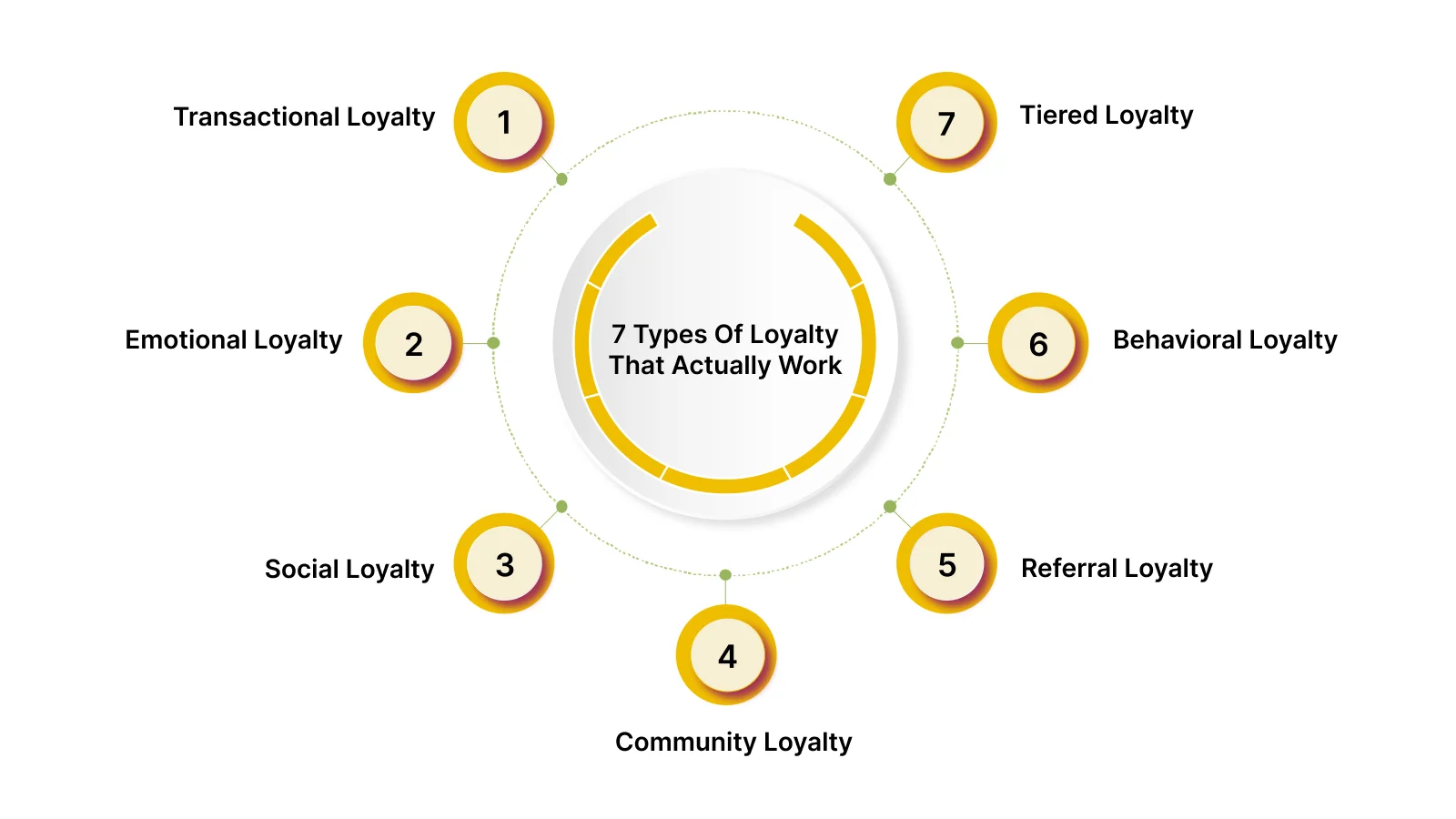
Customer loyalty is built through multiple layers of motivation—financial, emotional, social, and behavioral. Each type contributes differently to how customers connect with your brand and decide to return. Understanding these loyalty types helps you create a program that goes beyond rewards to build genuine, lasting relationships.
According to Bain & Company (2024), increasing customer retention by as little as 5% can boost profits by up to 95%. This shows that focusing on retention isn’t just smart marketing; it’s a direct path to higher profitability.
1. Transactional Loyalty: Rewarding Every Purchase
Transactional loyalty is the foundation of most reward systems. It motivates customers to make repeat purchases by offering something tangible in return, such as points, cashbacks, or discounts.
You can strengthen transactional loyalty by:
- Offering points per dollar spent that can be redeemed for products or coupons.
- Introducing milestone bonuses, such as a reward after five purchases.
- Using loyalty tools like Nector, which automate point allocation and redemption directly in your store’s checkout flow.
A clear and consistent reward structure ensures customers know exactly what they gain each time they buy from you, increasing repeat orders without extra effort.
If you’re ready to turn these different loyalty strategies into real, repeat revenue. Start your loyalty program with Nector today. Visit Nector Loyalty to get started.
2. Emotional Loyalty: Building Trust Beyond Discounts
Emotional loyalty grows when customers feel personally connected to your brand. It’s driven by shared values, authenticity, and consistent positive experiences. Unlike transactional loyalty, this one focuses on why customers love your brand rather than what they get from it.
To strengthen emotional loyalty, you can:
- Build campaigns around shared causes such as sustainability or animal welfare.
- Personalize communications using customer data from your CRM or marketing automation tools.
- Offer exclusive content or experiences that make customers feel valued, not just sold to.
A customer who feels emotionally invested in your brand is less likely to switch, even if competitors offer lower prices.
Also Read: Unleashing the Power of Customer Loyalty Programs - Top 10 Examples
3. Social Loyalty: Turning Engagement into Rewards
Social loyalty connects customer advocacy with your brand’s online presence. It encourages people to share, tag, and recommend your brand on platforms like Instagram, WhatsApp, or Facebook in exchange for recognition or rewards.
You can encourage social loyalty through:
- Rewarding customers for social actions such as following, sharing, or creating user-generated content.
- Highlighting customer stories or reviews on your website and social pages.
- Integrating tools like Judge.me or Loox to display authentic reviews alongside user photos.
Social loyalty transforms everyday engagement into meaningful exposure and brings in new customers through trusted, peer-based influence.
4. Community Loyalty: Creating Belonging
Community loyalty develops when customers identify with your brand community rather than just your products. It’s built on connection, shared goals, and the sense of belonging that keeps members engaged over time.
Ways to build community loyalty include:
- Creating a members-only space on Discord, Telegram, or your brand website.
- Hosting events, both virtual and in-person, that celebrate loyal customers.
- Introducing a “VIP Club” with early access to products or private discussions.
When customers feel like part of a tribe, they associate their identity with your brand and remain loyal beyond transactional benefits.
5. Referral Loyalty: Growing with Advocacy
Referral loyalty focuses on rewarding customers who bring others into your ecosystem. It combines trust with tangible rewards, making every satisfied customer a potential marketer for your brand.
To build referral loyalty:
- Offer dual-sided rewards, where both the referrer and the new customer benefit.
- Provide referral links through WhatsApp or email for quick sharing.
- Track referrals automatically using platforms like Nector, which also helps prevent fraudulent referrals.
This type of loyalty taps into one of the most powerful forces in commerce: word-of-mouth. People trust recommendations from peers far more than ads, making referrals a sustainable growth driver.
If you're ready to turn your customers into advocates, explore Nector’s Referral Program and start growing through word-of-mouth today.
6. Behavioral Loyalty: Rewarding Key Brand Actions
Behavioral loyalty rewards actions that indicate long-term engagement, not just purchases. This includes writing reviews, filling out surveys, downloading your app, or subscribing to newsletters.
To design behavioral loyalty effectively:
- Identify which actions contribute most to engagement or retention.
- Use automation tools to assign points or badges when customers perform these actions.
- Send personalized follow-ups that acknowledge their contribution to your brand community.
Recognizing these behaviors reinforces ongoing interaction, ensuring customers stay active even between purchases.
Also Read: What is a Customer Loyalty Program? A Beginner's Guide
7. Tiered Loyalty: Motivating with Progression
Tiered loyalty programs create excitement through structured milestones. They encourage customers to reach higher levels of rewards, giving a sense of progress and exclusivity.
A typical tiered loyalty program may look like this:
You can increase participation by:
- Displaying progress bars that show how close customers are to the next level.
- Sending automated reminders when users are about to reach a new tier.
- Offering experiential perks instead of just monetary ones.
Tiered systems add gamification to loyalty, keeping customers engaged and motivated to maintain or upgrade their status.
If you’re ready to turn your loyalty strategy into action, register with Nector and start building smarter retention today.
Understanding the types of loyalty is just the beginning; next, explore how brands turn these insights into actionable strategies.

7 Different Loyalty Strategies That Actually Drive Results
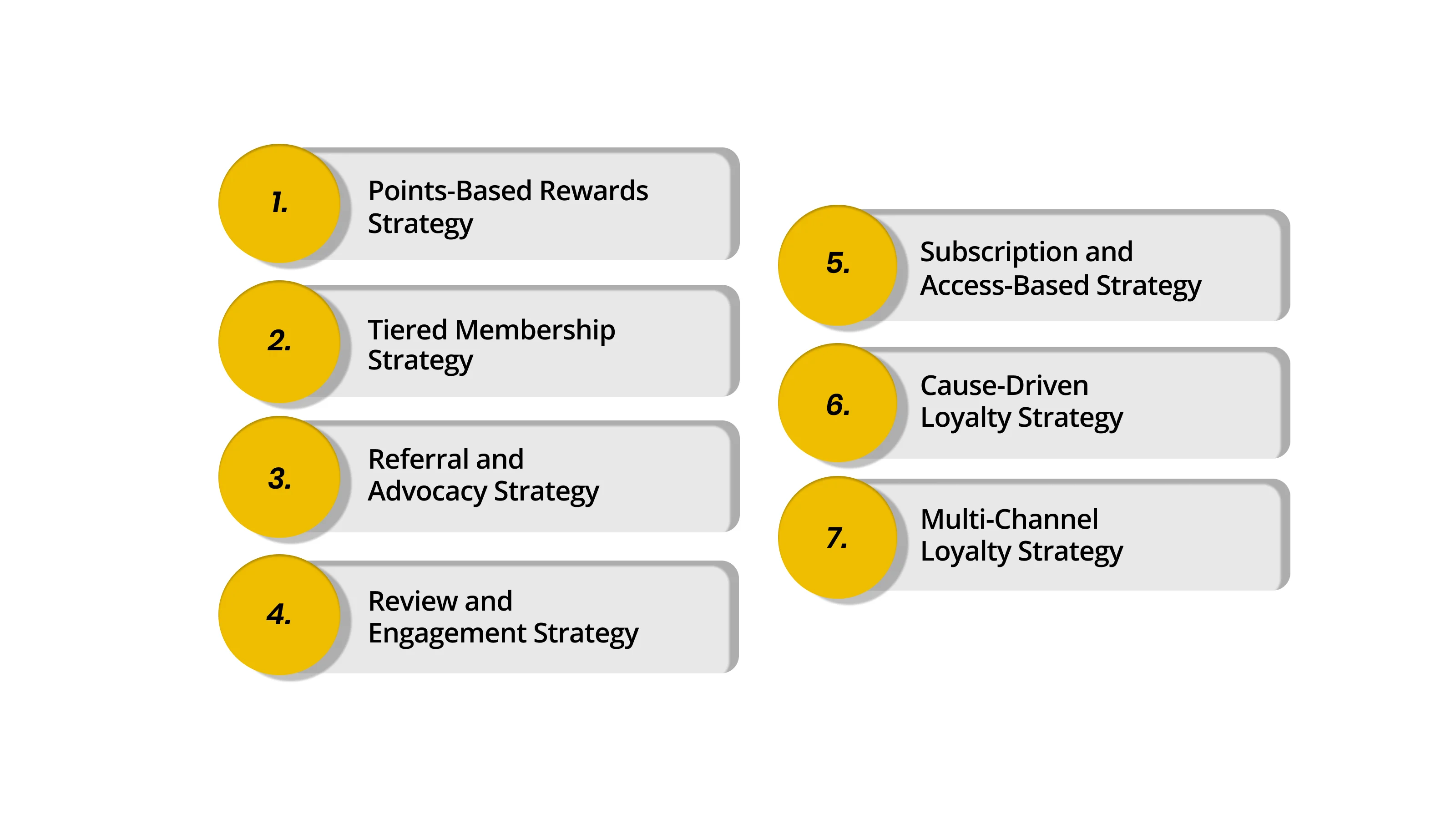
Successful loyalty programs don’t just reward customers; they create consistent habits and emotional ties that bring them back again and again. Each of these strategies offers a practical approach to improving retention, reducing acquisition costs, and turning casual shoppers into lifelong customers.
Recent research shows that 95% of consumers say customer service directly impacts their brand loyalty, and businesses that prioritize retention consistently see stronger ROI and long-term growth. These strategies form the foundation of a sustainable, customer-first growth model.
1. Points-Based Rewards Strategy: Encouraging Frequent Purchases
This is one of the simplest and most effective loyalty strategies for keeping customers active. You assign points for specific actions such as purchases, signups, birthdays, or referrals, and let customers redeem them for discounts or free products.
To make this system work efficiently:
- Define a clear earn and redeem structure (for example, 1 point per dollar spent).
- Offer bonus points during special campaigns or customer milestones.
- Automate the process using tools like Nector or LoyaltyLion, which track points, redemptions, and notifications in real time.
Example:
A D2C cosmetics brand offers 2 points for every dollar spent and 200 bonus points on birthdays. This keeps customers buying frequently to accumulate rewards faster, creating predictable repeat revenue.
2. Tiered Membership Strategy: Driving Aspiration and Repeat Sales
Tiered loyalty programs motivate customers to stay engaged through progress-based rewards. Each tier unlocks better perks, encouraging users to move up levels and spend more frequently.
Key elements of a strong tiered system include:
- Visible progression tools like progress bars or badges.
- Exclusive rewards such as free shipping or early access for higher tiers.
- Annual resets to encourage continuous participation.
Here’s a sample structure:
Example:
A lifestyle brand structures its membership around these tiers and uses gamified badges to celebrate milestones. The visible achievement system increases customer motivation to reach the next level.
Also Read: The Complete Guide to Customer Loyalty Programs: Boosting E-commerce Success in 2025
3. Referral and Advocacy Strategy: Turning Customers into Marketers
Referral programs transform satisfied customers into advocates. Instead of spending heavily on ads, you reward existing customers who bring in new ones. This approach builds organic growth through trust-based recommendations.
To make referrals effective:
- Offer dual incentives, rewarding both referrer and referee.
- Use shareable referral links via WhatsApp, email, or SMS.
- Track referrals automatically using platforms like Nector or ReferralCandy to prevent fraud and simplify management.
Example:
A home décor brand gives $10 store credit to both parties when a referred friend makes a purchase. Over time, referrals contribute to consistent, low-cost customer acquisition.
4. Review and Engagement Strategy: Rewarding Micro-Actions
Not all loyalty comes from purchases. Small engagement actions, such as leaving reviews or sharing posts, help build credibility and keep customers involved. Rewarding these behaviors turns everyday engagement into retention.
You can implement this strategy by:
- Offering points or coupons for verified reviews.
- Encouraging customers to share purchases on social media for small rewards.
- Integrating review tools such as Judge.me or Stamped.io to automate review collection and display.
Example:
A skincare startup gives 50 points for each verified review and a 10% discount when customers post a photo with their product on Instagram. These micro-actions improve both trust and visibility.
5. Subscription and Access-Based Strategy: Creating Exclusivity
Subscription-based loyalty focuses on long-term engagement through recurring memberships or access-based benefits. Customers pay a small fee or meet specific criteria to unlock premium experiences.
Strong subscription-based programs often include:
- Early access to new collections or seasonal drops.
- Members-only discounts or free shipping.
- Surprise perks like limited-edition samples or early event invites.
Example:
A specialty coffee brand introduces a $5 monthly membership offering first access to new blends, 10% off every order, and free shipping. The recurring model ensures consistent revenue and deepens emotional connection with customers.
6. Cause-Driven Loyalty Strategy: Building Emotional Connection
Customers increasingly align with brands that reflect their values. Cause-driven loyalty programs tie purchases to meaningful contributions, building trust and emotional attachment.
Effective cause-driven programs include:
- Donations per purchase, such as contributing a percentage to environmental or social causes.
- Transparency reports showing how contributions are used.
- Customer choice, allowing shoppers to select which cause their purchase supports.
Example:
An eco-conscious apparel brand donates $1 from each sale to ocean cleanup efforts. Customers see tangible impact from their purchases, creating loyalty through shared purpose rather than incentives.
7. Multi-Channel Loyalty Strategy: Unifying Experience Across Touchpoints
Multi-channel loyalty integrates all your customer touchpoints: website, mobile app, and physical stores, so rewards and experiences remain consistent everywhere.
To make your program cohesive across channels:
- Sync loyalty data through CRM or POS integrations like Shopify POS or Klaviyo.
- Ensure customers can earn and redeem rewards both online and offline.
- Use personalized messaging across email, SMS, and in-app notifications to maintain engagement.
Example:
A fashion retailer connects its loyalty program across website and retail stores, allowing customers to earn points in-store and redeem them online. The seamless experience encourages continuous engagement, regardless of where customers shop.
Once you know which strategies drive results, the next step is identifying which ones align best with your brand’s goals.
How to Choose the Right Loyalty Strategy for Your Brand
The ideal loyalty strategy depends on your brand’s size, audience, and long-term goals. Startups often need simplicity and automation, while established e-commerce brands benefit from layered systems that mix emotion, exclusivity, and engagement. Choosing the right combination ensures your program aligns with customer expectations and scales with your growth.
Below is a simple decision framework that helps you select loyalty approaches tailored to your business:
When selecting strategies, focus on scalability and customer motivation.
- For startups: Choose automated systems with minimal manual tracking.
- For mid-size brands: Introduce tiered or hybrid programs to encourage progression.
- For large enterprises: Implement integrated platforms with analytics for detailed segmentation and cross-channel consistency.
Using a loyalty platform like Nector or LoyaltyLion allows you to begin small and scale smoothly as your customer base expands. After choosing your ideal loyalty approach, it’s time to put it into action with a few practical implementation tips.
Implementing Different Loyalty Approaches: Practical Tips
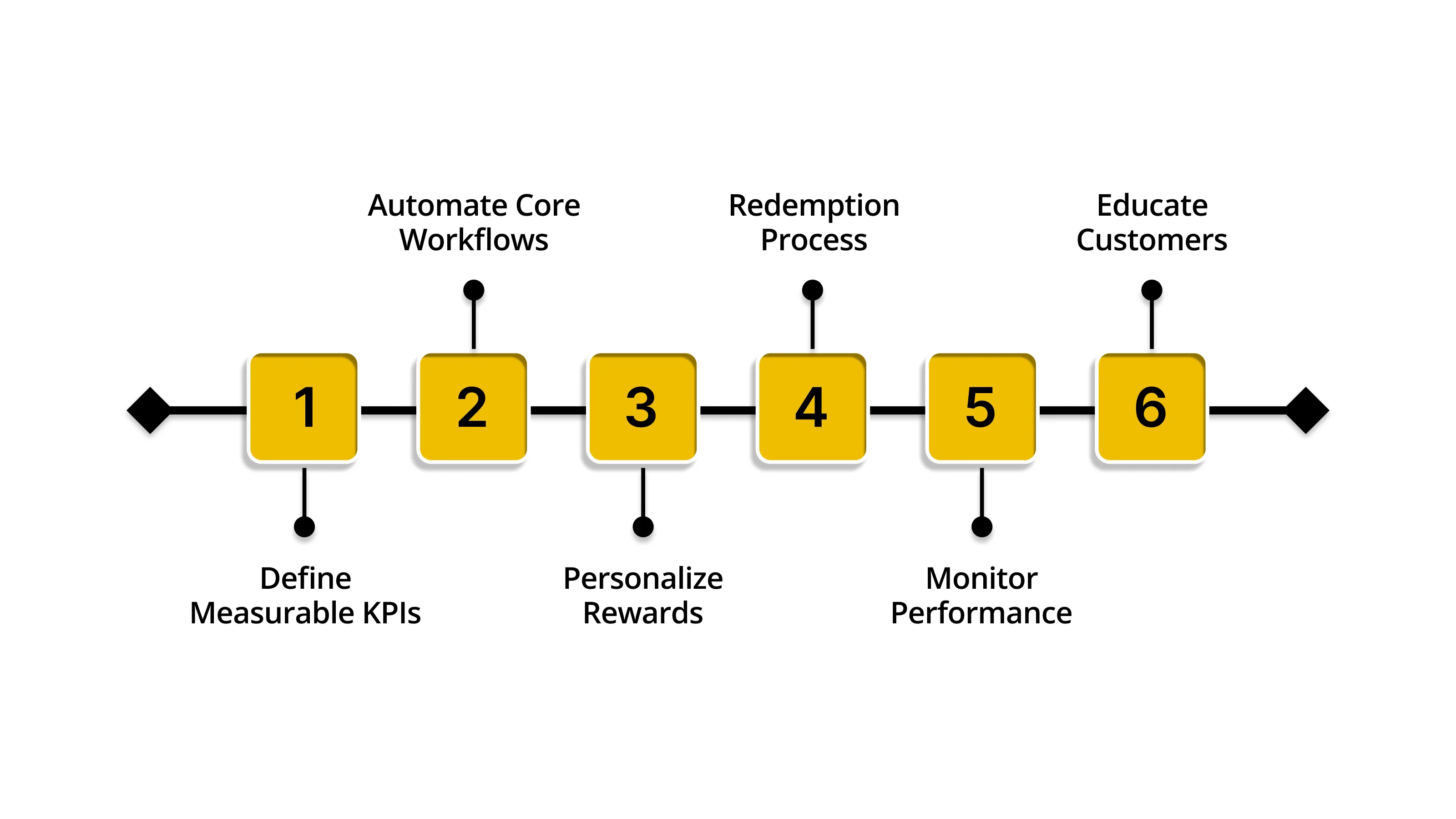
Loyalty programs succeed when built with structure, automation, and data-backed decision-making. The following tips outline a clear, step-by-step approach to implementing a loyalty strategy that’s both effective and sustainable.
1. Define Measurable KPIs
- Establish clear metrics such as repeat purchase rate, reward redemption rate, and customer lifetime value (CLV).
- Use tools like Google Analytics or Shopify’s analytics dashboard to track retention metrics consistently.
2. Automate Core Workflows
- Set up automation for point distribution, tier upgrades, and referral tracking to reduce manual oversight.
- Platforms like Nector or Klaviyo can automatically send loyalty updates and reward notifications.
3. Personalize Rewards Using Customer Data
- Segment your audience by purchase behavior or demographics.
- Offer relevant incentives, such as bonus points for specific product categories or personalized birthday discounts.
4. Simplify the Redemption Process
- Make reward redemption available at checkout to minimize friction.
- Provide multiple options—discounts, store credits, or free shipping—to suit varied preferences.
5. Monitor Performance and Adjust Regularly
- Schedule quarterly reviews to analyze engagement levels and reward redemption.
- Adjust point values or tier benefits based on participation data to maintain excitement and fairness.
6. Educate Customers About the Program
- Clearly explain how the loyalty system works through banners, emails, and post-purchase messages.
- Add a visible progress tracker so customers know how close they are to their next reward.
Practical implementation requires consistent optimization. The best programs evolve with customer behavior, ensuring your efforts remain aligned with both business objectives and audience expectations. Building a program is only half the work; you also need to measure its performance to ensure long-term success.
Measuring the Success of Different Loyalty Strategies
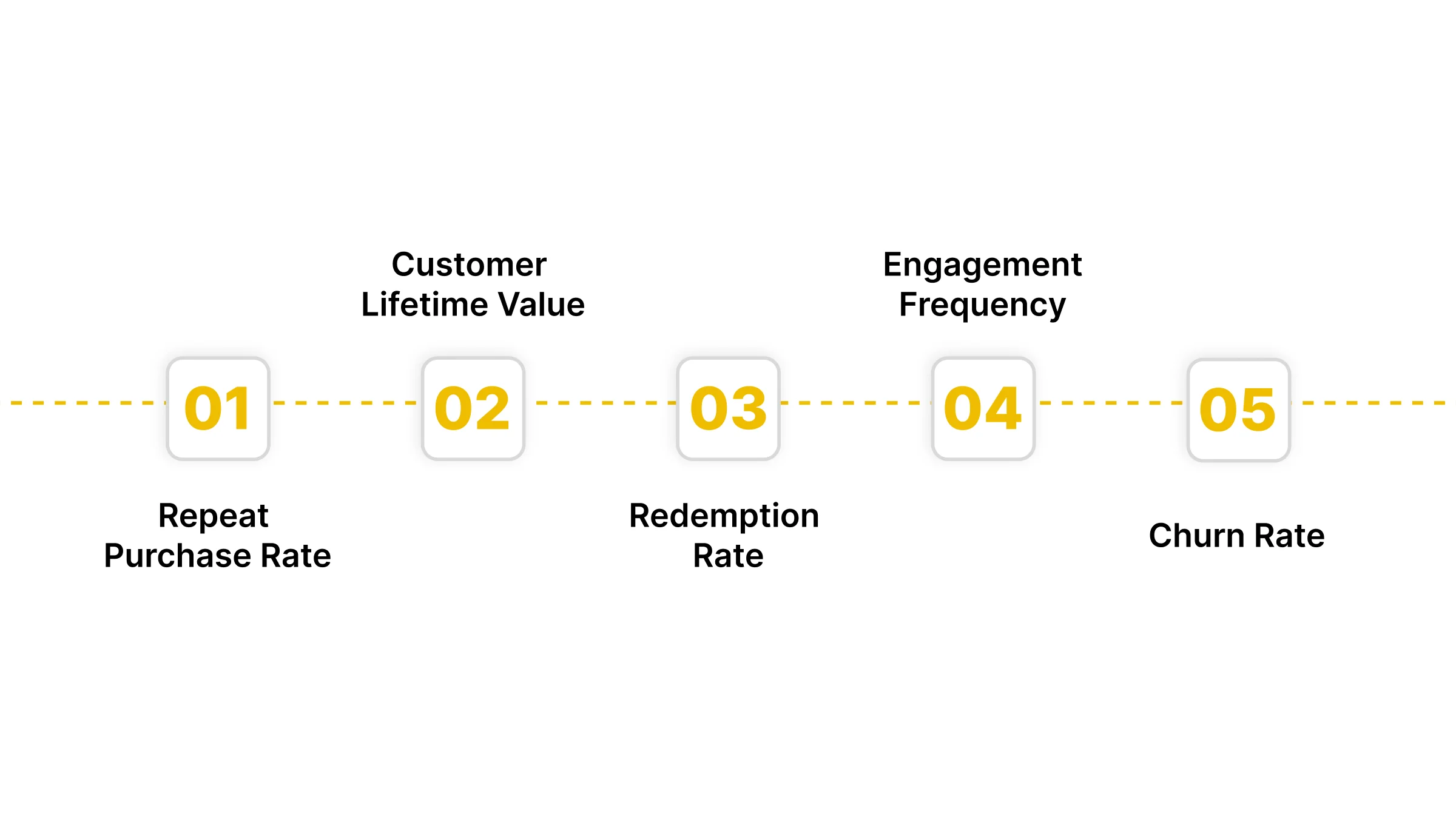
Tracking success ensures your loyalty strategy is not just active but effective. Measurement should combine quantitative data with behavioral insights to identify what drives retention and profitability.
Key metrics to track include:
- Repeat Purchase Rate: Indicates how often customers return after their first transaction.
- Customer Lifetime Value (CLV): Measures total revenue generated by a customer over time.
- Redemption Rate: Shows how many customers actually use earned rewards, reflecting program engagement.
- Engagement Frequency: Tracks interactions such as referrals, reviews, and social shares.
- Churn Rate: Reveals how many customers stop engaging or purchasing within a defined period.
For clarity, here’s how these metrics align with specific program goals:
Use A/B testing and benchmarking to compare results over time. For instance, if your repeat purchase rate rises after introducing tier upgrades, it signals that your reward progression resonates with your audience.
Regular analysis ensures your loyalty program stays profitable and adaptive. When you evaluate performance based on data, you can make strategic adjustments that lead to higher engagement, stronger retention, and measurable business growth.
Also Read: Maximizing Customer Loyalty Programs in Service-Based Businesses
Managing all these strategies manually can be complex, which is why Nector simplifies and unifies them for scalable growth.
How Nector Turns Different Loyalty Strategies into Growth Results
Running all these strategies manually isn’t easy, especially when your goal is to maintain consistency, accuracy, and personalization across every customer interaction. This is where Nector brings them together effortlessly—allowing you to manage multiple loyalty approaches within a single, unified dashboard.
Nector simplifies the process by combining points-based, tiered, referral, and behavioral loyalty programs under one system. Each strategy works together to create measurable growth outcomes such as higher repeat purchases, improved engagement, and stronger customer retention.
Here’s how Nector supports different loyalty strategies effectively:
- Points-Based Rewards:
- Automates point allocation for purchases, reviews, referrals, and social actions.
- Allows customers to redeem points directly at checkout for instant gratification.
- Provides custom point rules so you can define how rewards are earned and used.
- Automates point allocation for purchases, reviews, referrals, and social actions.
- Tiered Memberships:
- Includes progress bars for tier tracking, helping customers visualize their journey toward higher rewards.
- Lets you set tier-specific perks such as exclusive access or double-point days.
- Automates tier upgrades and notifications without manual intervention.
- Includes progress bars for tier tracking, helping customers visualize their journey toward higher rewards.
- Referral and Advocacy:
- Offers dual-sided referral rewards, ensuring both referrers and new customers benefit.
- Tracks referrals accurately, preventing misuse or duplicate claims.
- Integrates with email, SMS, and WhatsApp to make referral sharing simple.
- Offers dual-sided referral rewards, ensuring both referrers and new customers benefit.
- Behavioral Engagement:
- Rewards actions like leaving reviews, signing up, or completing profiles.
- Uses automated triggers to send personalized messages when milestones are achieved.
- Encourages consistent engagement beyond just purchases.
- Rewards actions like leaving reviews, signing up, or completing profiles.
- Automation and Personalization:
- Nector’s smart automation handles reward tracking, point redemption, and customer segmentation seamlessly.
- Personalizes campaigns based on customer behavior, purchase history, and engagement data.
- Integrates with Shopify, Klaviyo, and Mailchimp to maintain a unified experience across all marketing channels.
- Nector’s smart automation handles reward tracking, point redemption, and customer segmentation seamlessly.
By managing these strategies through Nector, you save time, reduce manual tasks, and ensure every loyalty interaction adds measurable value to your business. It transforms retention from a complex process into a streamlined, automated system that supports growth at scale.
Case Study: Vilvah Store — Driving 50%+ Repeat Customer Engagement with Nector
Vilvah Store, a leading skincare brand known for its clean formulations and sustainable ethos, wanted to improve customer retention without relying on discounts. As the brand scaled across both online and offline channels, it needed a unified loyalty system that could reward customers consistently while encouraging repeat purchases and advocacy.
The Challenge
Vilvah faced growing complexity in retaining high-intent buyers across channels. The brand had strong first-time traction but lacked a structured way to recognize loyal customers, promote referrals, and maintain long-term engagement.
The Solution
By implementing Nector’s all-in-one loyalty platform, Vilvah created a seamless system where customers could earn and redeem coins across online and offline stores. The brand activated loyalty points, birthday rewards, and referrals to make every purchase more meaningful.
Results (May–July 2025):
- 93% higher Average Order Value (AOV) among loyalty members
- 18% of total orders driven by repeat customers using loyalty features
- 24.6% average coin redemption rate, proving strong engagement and perceived value
Key Features Used:
- Loyalty widget for on-site engagement
- Dual-channel coin redemption (online + offline)
- Referral and birthday rewards automation
Vilvah’s success demonstrates how Nector transforms loyalty strategies into measurable business growth, helping brands create high-value, repeat customers without discount dependency.
Conclusion
Customer loyalty is built on a balanced mix of emotion, reward, and ease. The most effective loyalty strategies combine meaningful experiences with tangible incentives that make customers feel appreciated rather than targeted. A strong program doesn’t just push repeat purchases—it creates long-term engagement by making every interaction valuable and every customer journey seamless.
This is where Nector becomes an enabler for growth. It unites multiple loyalty strategies like points-based rewards, tiered programs, referrals, and behavioral engagement, etc. into one simplified system. With built-in automation, real-time tracking, and personalized experiences, Nector helps you deliver loyalty programs that feel natural to customers and manageable for your team.
If you want to build a loyalty experience that feels effortless for both you and your customers, Nector helps you do it in one place. Book a demo with Nector today and see how effortless customer retention can be.
FAQs
Q: How can small e-commerce brands start implementing different loyalty strategies effectively?
A: Begin with one or two easy-to-manage strategies like points-based rewards or referrals. Use automation tools to track engagement, redemptions, and customer retention metrics.
Q: What makes emotional loyalty different from other loyalty strategies?
A: Emotional loyalty focuses on building genuine connections through shared values and trust. Customers stay because they feel understood, not just rewarded.
Q: How can loyalty strategies improve customer lifetime value (CLV)?
A: Combining behavioral and tiered strategies increases engagement frequency. Over time, customers purchase more often, raising total revenue per user.
Q: Can different loyalty strategies work together within one program?
A: Yes. Blending approaches like referrals, points, and emotional loyalty creates balanced engagement, covering multiple customer motivations effectively.
Q: How can you measure if your loyalty strategy is performing well?
A: Track repeat purchase rates, redemption activity, and referral participation. Compare these results quarterly to optimize engagement and retention outcomes.
Q: Why should brands use a unified platform like Nector for loyalty programs?
A: Managing multiple strategies manually can be complex. Nector automates rewards, referrals, and analytics, helping brands scale loyalty seamlessly.
FAQs
Start Building Customer Retention That Lasts


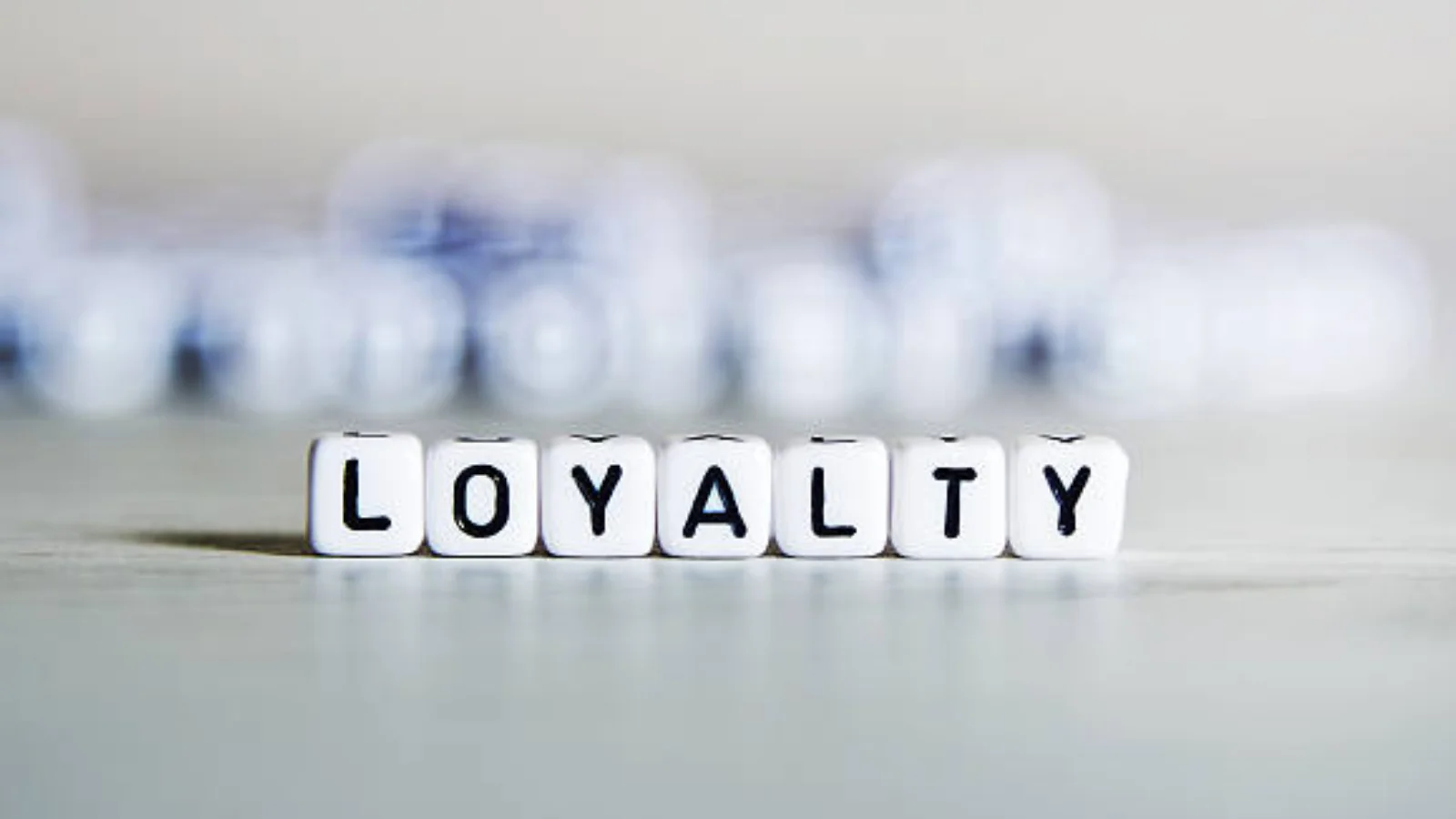

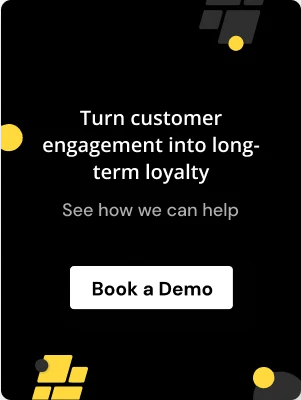
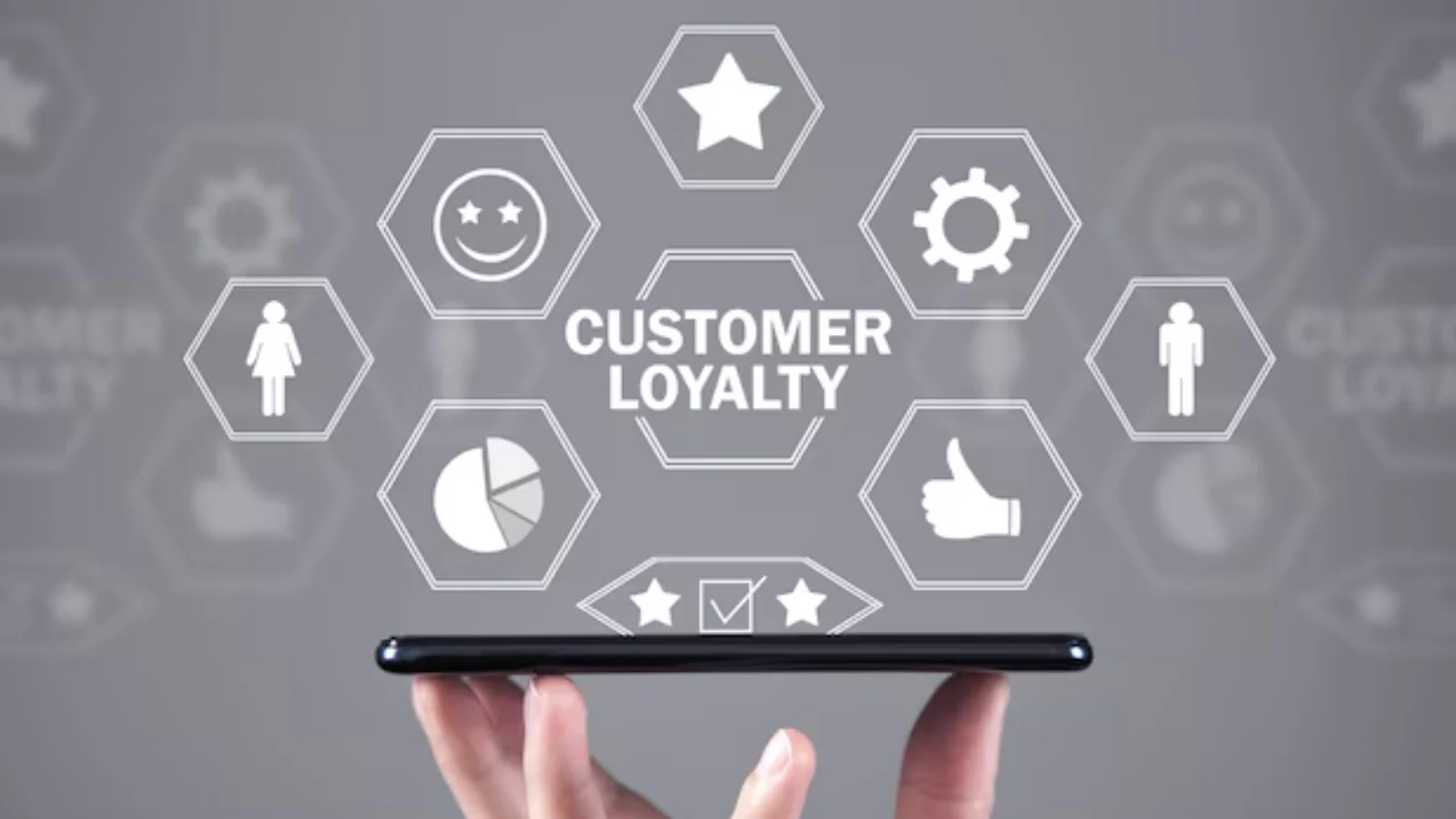
%201.webp)
%201.webp)

